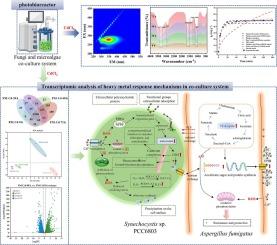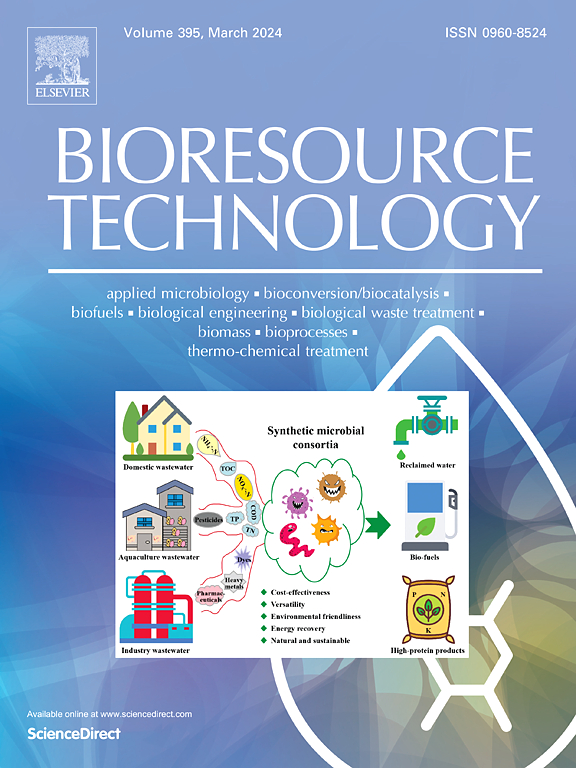光生物反应器中真菌-微藻颗粒用于重金属废水生物修复的机理研究。
IF 9.7
1区 环境科学与生态学
Q1 AGRICULTURAL ENGINEERING
引用次数: 0
摘要
收获微藻的高昂成本限制了微藻的工业应用。真菌-微藻颗粒可以有效地收获微藻,并增强对重金属的吸附。然而,真菌-微藻颗粒在重金属胁迫下的分子响应机制仍不清楚。以光生物反应器中的真菌-微藻颗粒为研究对象,在 pH 值为 5.0-6.0 的条件下添加外源碳和氮,共培养 12 小时,收获效率可达 98%。细胞外高分子物质(EPS)中富含腐殖酸和色氨酸的蛋白质参与了镉(II)的络合。真菌-微藻颗粒中的镉(II)反应涉及氨基酸、葡萄糖、脂类、能量代谢和抗氧化系统。转折点出现在 48 h。脯氨酸、组氨酸和谷氨酰胺的合成以及腺苷-三磷酸(ATP)结合盒(ABC)转运途径在抵抗镉(II)生物毒性中发挥了重要作用。该研究为大规模培养真菌-微藻共生颗粒以及工业重金属废水的实际应用提供了参考。本文章由计算机程序翻译,如有差异,请以英文原文为准。

Mechanistic insight of fungal–microalgal pellets in photobioreactor for heavy-metal wastewater bioremediation
The high cost of harvesting microalgae limits their industrial application. Fungal–microalgal pellets can efficiently harvest microalgae and enhance heavy-metal adsorption. However, the molecular response mechanism of fungal–microalgal pellets under heavy-metal stress remains unclear. Fungal–microalgal pellets in a photobioreactor were used as a research object, and a 98 % harvesting efficiency could be achieved with adding exogenous carbon and nitrogen at pH 5.0–6.0 for 12 h of co-culture. Humic acid- and tryptophan-rich proteins in extracellular polymeric substances (EPS) participate in Cd(II) complexation. The Cd(II) response in fungal-microalgal pellets involves amino acids, glucose, lipids, energy metabolism, and antioxidant systems. The turning point was at 48 h. Proline, histidine, and glutamine synthesis and the adenosine-triphosphate (ATP) binding cassette (ABC) transport pathway play important roles in resistance to Cd(II) biotoxicity. This study provides a reference for the large-scale cultivation of fungal-microalgal symbiotic pellets and the practical application for industrial heavy-metal wastewater.
求助全文
通过发布文献求助,成功后即可免费获取论文全文。
去求助
来源期刊

Bioresource Technology
工程技术-能源与燃料
CiteScore
20.80
自引率
19.30%
发文量
2013
审稿时长
12 days
期刊介绍:
Bioresource Technology publishes original articles, review articles, case studies, and short communications covering the fundamentals, applications, and management of bioresource technology. The journal seeks to advance and disseminate knowledge across various areas related to biomass, biological waste treatment, bioenergy, biotransformations, bioresource systems analysis, and associated conversion or production technologies.
Topics include:
• Biofuels: liquid and gaseous biofuels production, modeling and economics
• Bioprocesses and bioproducts: biocatalysis and fermentations
• Biomass and feedstocks utilization: bioconversion of agro-industrial residues
• Environmental protection: biological waste treatment
• Thermochemical conversion of biomass: combustion, pyrolysis, gasification, catalysis.
 求助内容:
求助内容: 应助结果提醒方式:
应助结果提醒方式:


